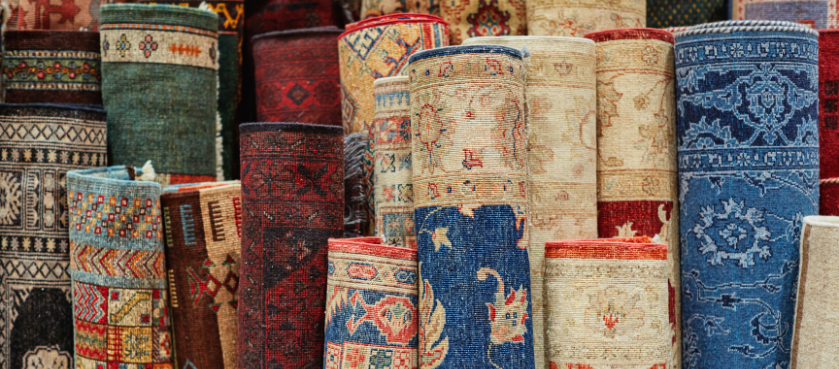Carpets have long been a centrepiece of interior décor around the world, providing not just aesthetic beauty but also comfort and warmth. From the opulent silk carpets of the Persian empires to the humble woollen floor coverings of medieval European homes, carpets have played a crucial role in the cultural and social fabric of many civilisations. In this article, we’ll explore the fascinating journey of carpets through history, tracing their evolution and highlighting their significance in various cultures. Cleanwise Carpet Care, leaders in carpet and upholstery cleaning services in Sheffield, Rotherham, Barnsley & Chesterfield, values the deep history and cultural significance behind every carpet we care for.
Origins and Early History
The history of carpets can be traced back to the nomadic tribes of Central Asia over 2,500 years ago. These early carpets were primarily functional, used as floor coverings to provide warmth and insulation inside tents. Made from sheep’s wool, these carpets were hand-knotted, a technique that would evolve into various styles and forms over centuries.
One of the oldest surviving carpets is the Pazyryk carpet, dating back to the 5th century BC. Discovered in a Scythian tomb in Siberia in the 1940s, the Pazyryk carpet is an exceptional example of fine workmanship, detailed with rich colours and intricate designs that indicate a highly developed weaving technique, far advanced for its time.
The Golden Age of Carpet Weaving
The true art of carpet weaving flourished in the Islamic world during the medieval period, particularly in Persia (modern-day Iran), where carpet weaving evolved into a major art form. The introduction of intricate designs, vibrant colours, and sophisticated weaving techniques marked this era. Persian carpets from this period are renowned for their elaborate patterns and superior craftsmanship, often featuring floral motifs, geometric shapes, and detailed pictorial scenes.
This period also saw the emergence of various carpet-weaving centres across the Middle East and Central Asia, each developing its own distinctive styles and techniques. Cities like Tabriz, Kerman, and Isfahan in Persia became famous for their unique carpets, which were highly sought after in both the Eastern and Western worlds.
Carpets in the Western World
Carpets were introduced to Europe by the Crusaders in the Middle Ages, who brought them back from the East as luxury items. By the Renaissance, carpets had become valuable status symbols among the European elite. Initially, these precious textiles were used as table coverings or wall hangings rather than floor coverings, reflecting their perceived value and artistic merit.
The 17th and 18th centuries saw the establishment of numerous carpet manufacturing industries in Europe. Notable among these was the Savonnerie factory in France, which was established in the early 17th century to produce carpets specifically for the Royal Palaces. The designs of these early European carpets were heavily influenced by Oriental patterns but gradually evolved to incorporate more local themes and styles.
Industrial Revolution and Modernisation
The Industrial Revolution brought significant changes to carpet production. The invention of the power loom in the 19th century by Erastus Bigelow dramatically changed the carpet industry, allowing for faster production and making carpets more accessible to the middle class. This period also saw the rise of synthetic dyes, which replaced the traditional vegetable dyes, leading to a wider range of colours and patterns.
In the 20th century, the introduction of synthetic fibres such as nylon transformed the carpet industry once again, offering durability and stain resistance at a lower cost than natural fibres. This innovation made carpets even more popular as a practical and decorative floor covering in homes around the world.
Contemporary Trends and Sustainability
Today, the carpet industry continues to evolve with a strong focus on sustainability and environmental responsibility. Modern carpet manufacturers, including those serviced by Cleanwise Carpet Care, are committed to using sustainable materials and processes. This includes recycling old carpets, using eco-friendly materials, and reducing water and energy use during production.
The design of carpets has also become more diverse, reflecting global influences and contemporary aesthetic trends. Technological advancements have made it possible to create a wide range of textures, patterns, and colours, allowing carpets to remain a central element of modern interior design.
Carpets through the Ages
The history of carpets is a testament to human creativity and ingenuity, reflecting cultural, technological, and artistic developments across centuries. From ancient nomadic tribes to modern industrial producers, carpets have continually adapted to meet the needs and tastes of different times and places. At Cleanwise Carpet Care, we recognise the rich history and cultural significance of every carpet we clean, treating them not just as household items, but as pieces of history that beautify and enrich our lives. As we look to the future, we are committed to preserving these treasures for generations to come, ensuring they continue to tell their stories and add warmth and beauty to homes across South Yorkshire and Derbyshire.





